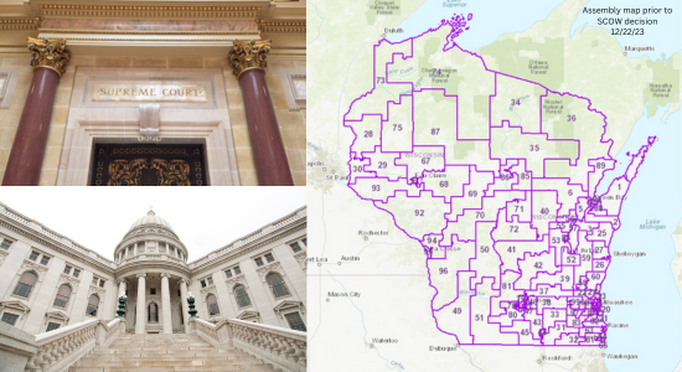|
By Margo Kirchner Wisconsin Justice Initiative on Monday filed a friend-of-the-court brief in the pending redistricting litigation before the Wisconsin Supreme Court, urging the court to pay close attention to the requirement that Wisconsin Assembly districts follow county, town, or ward lines. The Wisconsin Constitution calls for assembly districts “to be bounded by county, precinct, town or ward lines, to be contiguous territory and be in as compact form as practicable.” On Dec. 22, 2023, the Wisconsin Supreme Court held that the maps then in place violated the contiguity requirement. The court then set forth a process for its selection of replacement maps if the Legislature and governor fail to adopt new maps through legislation. Parties to the case filed six sets of proposed maps and supporting materials on Jan. 12, 2024. WJI's brief responds to those proposals. WJI filed the brief together with the Wisconsin Fair Maps Coalition (FMC), an unincorporated coalition of citizen activist groups including the Wisconsin Maps Assessment Project (WIMAP). WIMAP is a team of volunteers from across Wisconsin who love maps and math. During the past few years they have analyzed every statewide redistricting map submitted to the supreme court during litigation or to the People's Maps Commission. In November 2023, WIMAP published Wisconsin Redistricting 2020-2022. WIMAP assessed the six proposed maps submitted to the court and noticed stark differences in compliance with the constitutional requirement that assembly districts follow ward lines. Four maps had zero or just a few "ward splits," while two maps had far more. The constitutional language on following ward lines yields to federal-law requirements regarding districts having generally equal population. In the past, before recent technology advances, courts did not require maps that adhered strictly to the boundary requirement in light of the difficulty in complying with the various federal-law and state constitutional requirements. In its Dec. 22 redistricting decision, for instance, the court noted that it "no longer interpret(s) the requirement to entirely prohibit any splitting of the enumerated political subdivisions." Dissenting from that decision, Justice Brian Hagedorn wrote that “absolute compliance with the ‘bounded by’ clause is impossible given the one-person, one-vote decisions of the United States Supreme Court.” He added that contiguity and avoiding town and ward splits were requirements pitted against each other and might not both be met by proposed maps. WJI and FMC argue in their brief that two of the proposed maps show that with today's technology complete compliance with equal-population, contiguity, and ward-boundary requirements is possible. "Mapmakers have presented this Court with districts that are contiguous, bounded by ward lines, compact as practicable, and more," the brief says. Further, the brief argues that even if the court accepts some ward splits, they should be few and not "gratuitous," as the court itself noted in a prior redistricting case. Two of the submitted maps fail regarding ward splitting, say WJI and FMC in their brief. The map submitted by the individuals who succeeded in the last redistricting litigation in 2021-2022 (known as the Johnson intervenors) contains 13 ward splits, and the map submitted by the Legislature and Republican state senators contains 51 ward splits, per those parties' own counts. "Even citizen math and map enthusiasts like the WIMAP members, who lack the experience and technology of the parties and Court’s consultants, can see that two of the parties—the Johnson intervenors and the Legislature—presented maps with what can be called 'gratuitous' ward splits," the brief says. WJI and FMC urge the supreme court to reject those parties' attempts to downplay the significance of ward splitting. The adopted map should comply with the constitutional requirement that assembly districts not split wards, and the court should reject the Johnson intervenors' and Legislature's maps on this ground, WJI and FMC argue. "Wisconsinites need an end to maps that fail to comply with the Wisconsin Constitution. Mapmakers should create maps that comply with not just parts of it, but all of it. Certain parties in this case have shown that such maps are possible. Ward splits, which previously were thought impossible to avoid, can be avoided," the brief says. "Maps that comport with the “bounded by” clause in the Constitution should be preferred over maps that do not." "Wisconsinites need an end to maps that fail to comply with the Wisconsin Constitution. Mapmakers should create maps that comply with not just parts of it, but all of it.
0 Comments
Your comment will be posted after it is approved.
Leave a Reply. |
Donate
Help WJI advocate for justice in Wisconsin
|
Copyright © 2024 Wisconsin Justice Initiative Inc.
The Wisconsin Justice Initiative Inc. does not endorse candidates for political office. The Wisconsin Justice Initiative Inc. is a 501(c)3 organization.
The Wisconsin Justice Initiative Inc. does not endorse candidates for political office. The Wisconsin Justice Initiative Inc. is a 501(c)3 organization.


 RSS Feed
RSS Feed